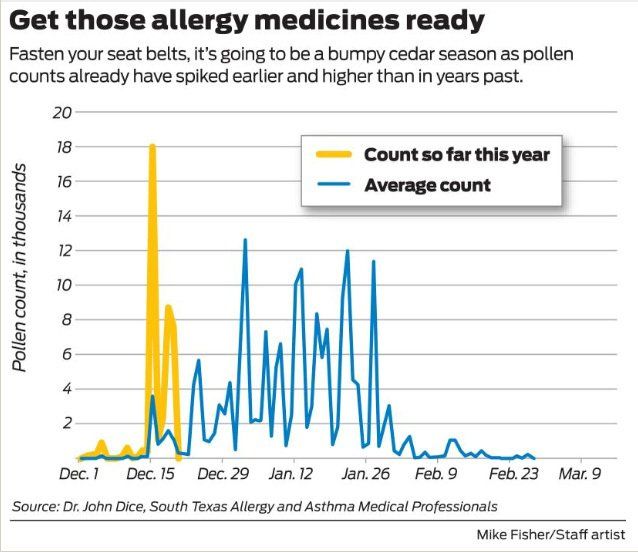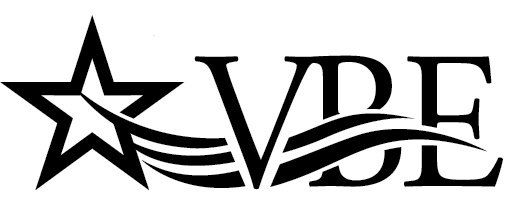
This story was originally published by San Antonio Express News and can be found here.
Recent rains, especially following a long, hot summer, have benefited the Edwards Aquifer and lawns alike. But in addition to a bountiful blessing of mosquitoes (tamped down by last month’s cold snap), the rains also left the ash juniper trees in the Hill Country locked and loaded with pollen sure to make cedar fever sufferers miserable for the next several months.
“We’re bracing for it,” said Dr. Erika Gonzalez, medical director of the South Texas Allergy and Asthma Medical Professionals, which treats plenty of allergy sufferers. “Cedar season usually runs from mid-December to mid-February, but this year the first cedar pollen was detected on Dec. 1, two weeks ahead of schedule. And we expect it to last longer than usual, too.”
While the highest pollen counts ever recorded in the area occurred about 10 years ago, when they topped 90,000 grains per cubic meter of air, the count already has spiked to 18,000 several times this season.
To put that in perspective, Gonzalez said people start experiencing allergy symptoms — congestion, runny nose, itchy, watery eyes — when the pollen count reaches 20 or so. That’s 20, not 20,000.
The Asthma and Allergy Foundation of America recently named San Antonio one of the fall 2018 allergy capitals of the country. The city came in fourth overall, following McAllen, Louisville, Kentucky, and Jackson, Mississippi, based on pollen and mold counts, allergy medication usage and the availability of board-certified allergists.
Not long ago, that would have been bad news for Chris Willis. A “lifelong” allergy sufferer, he’s been getting allergy shots at the Gonzalez’s far West Side allergy clinic for about three months, and already his symptoms are diminishing.
“I couldn’t breathe, I couldn’t sleep, I had a sore throat and I sometimes missed work,” said the 32-year-old IT worker. “I’d have allergies all year, but cedar fever season was the worst.”
To protect yourself this winter, it’s important to understand the enemy. So here are some things you need to know about cedar fever.
First, despite the name, it’s not caused by cedar trees nor does it cause a fever. Instead, cedar fever is an allergic reaction to the microscopic pollen launched into the air by the male Ashe juniper tree. Prevailing winds can send these tiny grains hundreds of miles.
If they land on a berry produced by the female tree, the result is often a baby ash juniper. If they land in your nose, they can make your life torture.
That’s right, the symptoms that make you more miserable than those post-holiday credit card bills are nothing more than the unintended consequence of a complex woodland mating dance.
While ash juniper is a Texas native, back in the day it was restricted to canyon areas and along creeks, according to Jim Rooni, head of Central Texas operations for the Texas A&M Forest Service.
“Because we don’t generally have wildfires anymore, these trees have extended their range across about 12 million acres of the Texas Hill Country,” Rooni said.
As development spreads ever deeper into the Hill Country, he said he finds it funny when homeowners clear their property in the belief that eliminating the trees will eliminate their allergies.
“Cedar fever isn’t a local problem, it’s a regional problem,” he said. “I tell these homeowners to drop the chainsaw and visit the drug store.”
That’s where allergy sufferers should start the fight against the fever. In recent years, new drugs and strategies have become available that not only can prevent symptoms, they can actually cure the allergy.
Over-the-counter antihistamines such as loratadine (brand name Claritin), cetirizine (Zyrtec) and fexofenadine (Allegra) target all the symptoms of cedar fever except the stuffy nose. For that, a saline nasal spray or neti pot can help flush out the nasal cavity.
Because these drugs aren’t as effective once symptoms have set in, it’s best to start early.
“We tell people to begin taking their meds at Thanksgiving, even if they don’t have symptoms, and to not stop until Valentine’s Day,” Gonzalez said.
More effective are nasal steroid sprays, such as fluticasone (Flonase), which has been available over the counter since 2015 and, by prescription, mometasone furoate (Nasonex). These do more than treat the symptoms, they help prevent the allergic reaction from taking place.
It can take 10 to 14 days for steroid sprays to reach their maximum efficacy, so it also makes sense to start using them before you start feeling symptoms.
Gonzalez recommends against long-term use of nasal decongestants such as oxymetazoline (Afrin). While they’ll clear up congestion in the short term, after about three days of use they’ll cause what’s known as a “rebound effect,” in which the congestion gets worse than it was initially.
For those truly hindered by cedar fever, allergy immunotherapy can often cure the condition, although this can take three to five years.
“The full course takes a while, but you may start seeing results in as little as five months,” Gonzalez said.
Fourteen-year-old Andrew Palacio has been getting shots at the clinic for eight months and said he’s already seeing benefits.
“My allergies would make my eyes so puffy I couldn’t open them,” Andrew said. “I had headaches and would sometimes even miss school.”
He said he hopes things will continue to improve, although the cedar pollen already is so thick that he’s had to take an occasional Zyrtec.
“I just needed an extra little boost,” he said. “But I’m feeling much better.
And those results are nothing to sneeze at.
This article has been updated to correct the spelling of Ashe juniper.
Are your Allergies bothering you?
Let our specialists provide you with world-class care.

Our Mission:
Guided by the needs of our patients, we deliver personalized comprehensive medical care through science and compassion.
Allergy & Asthma
Clinical Trials
Chronic Care
Covid-19
Locations
Olmos Park:
341 East Hildebrand
San Antonio, TX 78212
Westover Hills:
10447 State Highway 151
San Antonio, TX 78251
Medical Center:
Medical Tower II
7940 Floyd Curl Dr Ste 1050
San Antonio, TX 78229
Contact
Phone: (210) 616-5385
Fax: (210) 647-1012
info@staampallergy.com













